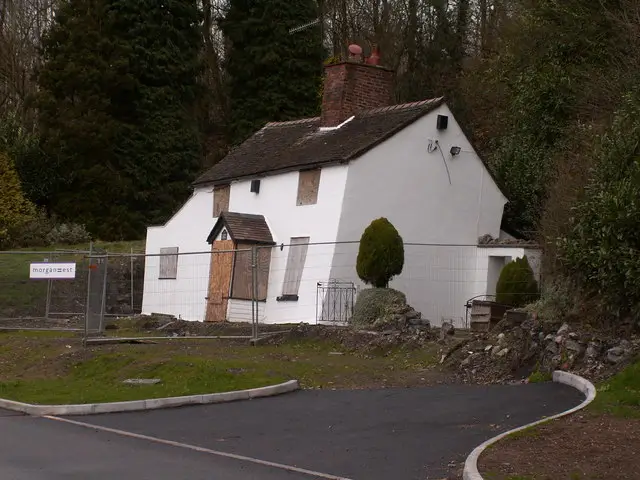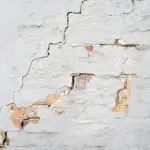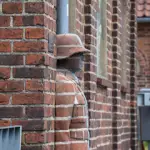
Having recently looked at a possible investment property that had signs of settlement, I questioned in my own mind about what is the difference between settlement and subsidence. So if I am questioning this point as a property owner and investor, I am sure others will have the same question.
The difference between settlement and subsidence is if the movement of the building happened in spite of the weight of the building, then the associated movement of the building will be as a result of subsidence vs settlement. Whereas settlement is cause by the weight of the structure on the ground.
That being said, the signs of settlement vs subsidence can be very similar when they occur. But settlement is more likely to happen within two years of a property being built, whereas subsidence can happen at any time.
What is subsidence in a house?
Subsidence is caused as a result of the ground beneath the house giving way, which happens in spite of the fact that a structure is built on top of it. With subsidence it is the giving way of the ground beneath a house that will cause part of the property to sink and destabilise the structure.
What can cause subsidence in a house?
There are a number of causes of subsidence in a house, which include the following:
- Shrinkage of clay soil. Clay soil can shrink when it dries, which is more likely to happen in a dry summer. Or large trees can suck the ground dry.
- Tree roots. Tree roots are one of the most common causes of subsidence, as trees extract water and moisture from the ground or soil beneath the property, which causes the soil to dry out and shrink. Trees most likely to cause subsidence problems include oak, elm, ash and willow trees.
- Mining. Underground mines can cause the ground to sink leading to subsidence, which is why where mining existed in an area, mining surveys are worth paying for before buying a property.
- Sinkholes. Sinkholes happen as a result of rainfall that percolates through the soil, which can create underground cavities and cause the ground to collapse or sink. Soils with a high sand or gravel content are more susceptible to sinkholes, as this type of soil is more vulnerable to being washed away.
- Old landfill sites. The rubbish that is found in landfill sites can rot or decompose over time and cause the ground to sink.
- Collapsing underground structures. Underground structures like old fuel tanks that rust can collapse and cause the land to sink.*
- Burst pipes. Flowing water from a burst pipe that’s under a property will cause the ground beneath to sink as the soil is eroded. This is more likely with sandy or gravelly soil types.
- Leaking drains. Water that leaks into the soil from drains can wash away the soil and destabilise the foundations of the house. This is more likely with sandy or gravelly soil types.
- Rivers. Flooding rivers can wash the land away, which can cause significant land slippage and cause houses to collapse or be completely washed away into the flooding river..
- Tidal storms. Erosion of the coastline can cause the land to fall away or collapse, which can lead to major subsidence, or for the whole property to fall into the sea.
* I recall this happening to a development near where I lived. The developer had built three properties on a plot, which had been built on underground tanks. These tanks collapsed and caused one of the properties to badly subside, but this happened after the house had been purchased.
What are the signs of subsidence in a house?
The signs to look out for with subsidence in a house include:
- Large cracks. These cracks can appear on internal walls, ceilings, outside brickwork or render. If the cracks spread diagonally across a wall, this is more likely to be subsidence. As is the case if the cracks are 3mm or wider and if the crack is wider at the top than it is at the bottom. But cracks due to subsidence are more often found close to doors and windows.
- Sloping floors. Sloping floors can indicate that one wall of a house has sunk due to subsidence. You can use a marble to check for sloping floors.
- Sticking doors or windows. If the doors or windows are sticking, this could be the first signs of subsidence, as it may indicate the frames have changed shape. When this gets worse, you may be able to spot a misshaped door or window frame, as per point 4.
- Sloping window or door frames. If you spot a sloping window or door frame, this may indicate the property is subsiding.
- Rippling in wallpaper. If a wallpapered wall is shifting as a result of subsidence, the wallpaper may begin to ripple.
- Cracks appearing on the line of an extension. If the ground beneath an extension subsides, the extension may sink away from the original building, which will leave a crack between the two structures.
What is settlement in a house?
Settlement happens as a result of the weight of a new house compacting the soil beneath, and cracks can arise as the ground adjusts to the weight of the new structure. Settlement generally occurs with new buildings and often happens within two years from the house being built.
In most cases a newly built home will have minor settlement cracks that can be filled and painted over.
What are the signs of settlement in a house?
The signs to look out for with settlement in a house include:
- Cracks in foundation walls. The foundation walls are the outside walls of the house, and it is quite normal to have hairline cracks, which are known as settlement cracks, appear in the plaster within the first few months post construction. This is normal and is caused by the ground settling due to the weight of the house on the soil beneath. If the cracks are bad and large, then there is a more serious problem with the foundations, which will need to be investigated and fixed. If larger cracks begin to appear a few years after your home was built, this means there is a problem with the foundations or this may be as a result of subsidence instead.
- Sticking doors or windows. Doors and windows can stick as a result of the door or window frame becoming misshaped due to settlement.
- Cracks above window or door frames. Cracks can often appear around doors and windows due to settlement. If these cracks are small they can be easily repaired, but if the cracks keep growing, you may have a bigger settlement problem that needs fixing.
- Uneven floors. If your floors are uneven or sloping, which can be tested using a marble, this could be a sign of some major settlement of the house foundation.
What can cause settlement in a house?
There are a number of causes of settlement in a house, which include the following:
- Weak soil structure. If a house has been built on a weak soil structure, this can result in settlement. Where weak soil structures are present, it is normal for piling to be used to support the foundations of the house, instead of poured concrete foundations.
- Clay soil shrinkage. Drying soils will shrink and this can cause the foundations to settle more than expected, although this is more likely to be referred to as subsidence when this happens.
- Poorly compacted soils. If the site has poorly compacted soil before construction begins, this may result in the land settling more than expected under the weight of the newly built house.
Does home insurance cover and pay for subsidence?
Most home insurance policies cover for damage caused by subsidence, but check your policy wording when at the time of insuring your property. But home insurance will not usually cover or pay for subsidence if the property has suffered from this in the past.
Does home insurance cover and pay for settlement?
Most home insurance policies don’t usually cover for damage caused as a result of settlement. But most builders pay for construction insurance like NHBC, which normally covers newbuilds for up to 10 years post construction for defects in the build, which will include major settlement problems.
Finally, you may also like to discover how you could save you up to £71,475 when you buy your next house if it would originally cost £350,000. Alternatively, if you propose to buy your next house for £250,000, the saving could be up to £51,852 instead.
To find out more, plus to get hold of my free mortgage savings calculator tool, please take a look at my video course about how to sell your house in under 2 weeks for more money.
I hope you’ve enjoyed this article about what is the difference between settlement and subsidence
If you’ve enjoyed this article about “what is the difference between settlement and subsidence” please share it on your favourite social media site.
Also, if you have any questions, please feel free to comment below too. Please also share any of your experiences with properties you’ve bought. Alternatively, if you need more help, please feel free to contact us on our contact us page here. Or join the discussion and ask your question in the property forum.




